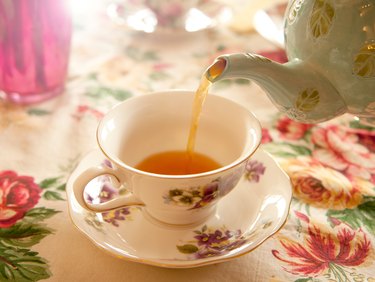
The research is solid when it comes to the health benefits of tea. So if you haven't already jumped on the tea bandwagon, we implore you to do so. However, brewing the wrong bag may actually do more harm than good.
Before you get sipping, make sure to follow these expert-recommended tea tips to guarantee a healthy mug.
Video of the Day
Video of the Day
Read more: Is Decaffeinated Tea Good for You?
1. When Buying Bagged Tea, Go With Paper Bags
A September 2019 study made headlines for revealing that some plastic tea bags (typically found in premium teas) release microplastics into our tea when brewed, research in Environmental Science & Technology found.
While this is cause for concern because we don't fully understand the effects microplastics have on our health — the World Health Organization (WHO) actually called for more research into this area — the truth is that the amount of tea bags containing plastic available on the market is actually pretty minimal.
"Bags made of nylon, PET (polyethylene terephthalate) and PLA (polylactic acid, a compostable material derived from cornstarch) together represent a very small portion of the tea bag business — probably less than five percent of total tea bags by volume," Peter Goggi, the president of the Tea Association of the USA, tells LIVESTRONG.com.
"Due to its biodegradability, PLA is the more popular of the three," Goggi says. "The vast majority of tea bags in use today are made from paper and have been used by companies and consumers for many decades with no health risks or issues."
So, chances are, if you're shopping for tea, you're likely buying brands that use paper bags. But if you're still concerned, you can also opt for loose-leaf tea.
Read more: 5 Unexpected Benefits of Drinking Matcha Tea
2. Exercise Caution When It Comes to Bleached Bags
There are both bleached and unbleached tea bags — and while it might seem like the move would be to go for the unbleached, not all of the bleached tea bags are created equal. Confusing? Yeah, we know.
Yes, picking unbleached is a smart play if you're trying to avoid unnecessary chemicals. But you'll want to choose oxygen-bleached bags, which undergo a natural process that's free of chemicals and toxins like dioxin found in bags that are bleached with chlorine. Brands that opt for unbleached bags or oxygen-bleached bags include Yogi, Clipper and Bigelow.
3. Look for Quality Leaves in Loose-Leaf
When it comes to processing tea, there are two main types of methods: orthodox and CTC (cut, tear, curl), according to the tea manufacturer Pure Leaf. The CTC method is more commonly used in tea bags and delivers a strong brew more quickly because the leaves are cut and curled into small pellets. If we were to equate this to oatmeal, these would be your quick-cook oats.
The orthodox (or long leaf) method, on the other hand, involves rolling the leaves to preserve the tea's complex flavors. It also takes longer to steep, thus the orthodox method would be your rolled oats. This type of tea should look like tea leaves and it shouldn't be crumbly or have stalks or pieces. They should have some heft to them and they shouldn't feel feather-light. If they do, this might be an indication that they've been over-dried.
4. Color Doesn’t Really Matter
Did you know that black and green teas all come from the same plant? You can thank the Camellia sinensis plant for these popular teas — and the varieties stem from differences in processing and levels of oxidization, according to the Tea Association of the USA.
When it comes to tea's health benefits, all teas pack in beneficial antioxidants and many have been linked to heart health benefits, according to the Academy of Nutrition and Dietetics. So if you prefer white over green or oolong over black, it doesn't matter — just drink tea and try to make it a regular habit.
5. Know How Long to Steep
While all of the different colored teas have health benefits, how you brew yours depends on the type of tea.
First, you'll want to bring filtered cold water to a full boil, and then pour the boiling water over the tea. Then, let it steep for three to five minutes. A good ratio to aim for is one teaspoon or one tea bag per cup of water.
But there are some variances when you're working with different teas, according to the Tea Association of the USA:
- Green tea: Once the water starts to boil, remove the teapot from the heat and let it sit for ten minutes. Then, pour the hot water over the green tea and let it brew for only 1 minute before serving.
- Oolong tea: Let the water temperature reach 180 to 190°F for big oolong teas and let it steep for 5 to 7 minutes.
- White tea: Let the water temperature reach 180 to 190°F for white teas and let it steep for 3 to 4 minutes.
- Environmental Science & Technology: "Plastic Teabags Release Billions of Microparticles and Nanoparticles into Tea"
- World Health Organization: "WHO Calls for More Research into Microplastics and a Crackdown on Plastic Pollution"
- The Tea Association of the USA: "Fact Sheet 2018-2019"
- Pure Leaf: "How to Identify Quality Tea"
- Academy of Nutrition and Dietetics: "The Health Benefits of Tea"
- Tea Association of the USA: "Brewing Tea"